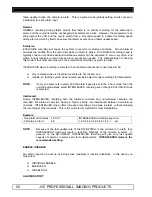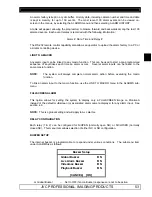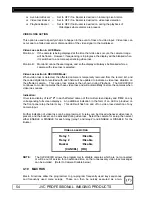
SW-D8000U, 16CH. COLOR VIDEO MULTIPLEXER
JVC PROFESSIONAL, IMAGING PRODUCTS 57
week, or at a preset time on every day of the week. Any macro can be started by each of the 20
scheduled events, and a macro can be started by more than one event.
MACRO TIMED START setup includes:
q
EVENT – Numbered 1-20 for scheduled events.
q
DAY - Select the day of the week (1-7) on which the event must start a macro. (The DAY of
the week corresponding to today’s date can be found in the DATE setup menu from the
TIME/DATE submenu.) If the macro is to be run every day at the same time, select ‘**’ for
the DAY field. If a ‘0’ is entered for the day, the scheduled event entry is canceled and will
not start the macro.
q
TIME - Select the time to run the macro function.
q
MACRO - Enter the number of the macro to run.
Keep a record of scheduled events for easy reference. A table is provided in the back of
this manual to list the scheduled events.
4.11 MOTION DETECTION
The
SW-D8000U
offers comprehensive motion detection capabilities, including built-in false alarm
rejection, sensitivity settings and size discrimination per camera. Motion detection is used to adjust
the rate at
SW-D8000U
alarm input, and can activate an output relay to cause automatic external
actions such as speed change on the VCR, or floodlights, or audio announcements and so on.
NOTE
: Some outdoor environments can have very complex intrusion detection requirements. In
those cases, it is preferable to use a motion detector intended specifically for complex
outdoor situations. If the unit is intended for Intrusion detection, read and understand the
whole of this section before installing the cameras and setting up the motion detection.
The difference between Intrusion detection and Activity detection:
When digital video motion detection is used, it is important to know the difference between simple
activity detection and intrusion detection.
Activity detection:
Activity detection simply looks for changes in the luminance in various selected areas of the screen,
and if changes are above a set threshold (sensitivity) then the activity detector interprets that to be
activity. Typically, activity detection is used to detect activity in crowded areas, where activity is not
the result of intruders and where human traffic is normal and expected.
Intrusion detection:
Intrusion detection looks for real movement in the scene, and raises an alarm if it is found. It is
used to monitor areas where no human traffic is allowed or expected, and so when movement is
found it will be likely that it was caused by an intruder, and so an alarm should result. It is hence
important that intrusion detectors do not cause false alarms, resulting from light changes, camera
vibration or random reflections of light in the scene. An ability to reduce false motion alarms, in
areas where no motion is expected, is the key difference between intrusion detection and activity
detection.
Upon selection of the MOTION DETECTION menu item, the following pull-down sub-menu
appears:
Enable / Disable Detection
Setup Active Zones






























